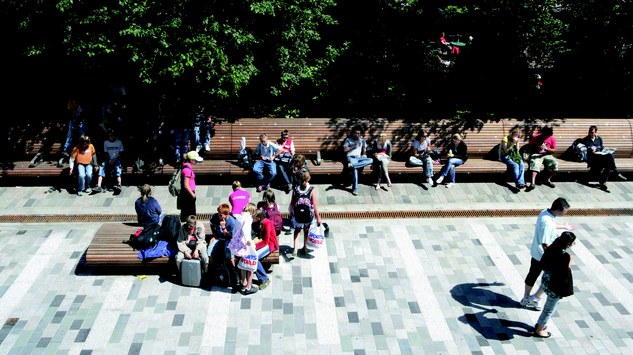Source: eea.europa.eu
Published: June 29, 2016
Our cities are under pressure like never before from increasing populations, traffic gridlock and climate change. How can we make them easier to get around, more liveable and sustainable? One urban design firm is helping transform the way we plan cities. We talked to Helle Søholt, founding partner and CEO of Gehl Architects, Copenhagen, to find out.

Brighton NewRoad Image © Gehl Architects
What does an ideal city look like and is such a model realistic?
It is difficult to create the perfect green city, but we do have an overall vision. Our key guiding principle can be summarised as ‘people first’. We are making cities for people — to support their ability to have a better quality of life in a sustainable way, while ensuring social inclusion both in the short and long term. We have to understand people’s physical and social requirements and their need to have access to work. In addition, cities must have a well-integrated mobility system and the capacity to deal better with climate change. We see cities struggling globally on these issues, but putting in place practical solutions to these issues is realistic.
In terms of mobility, well-built transport networks need to be put in place to ensure that the city is walkable and ‘bikeable’. People should be able to get around very easily, not only in their local neighbourhoods but also over distances between 5 and 10 kilometres away.
Public and green areas are also essential. They enable us to meet others and feel connected but also give us a sense of freedom and space beyond our private homes. A city needs a wide variety of accessible public spaces in local neighbourhoods like playgrounds for kids and families, local parks and calm areas that bring us closer to nature. People who have access to nature feel less stress in urban environments.
A city should also have other types of public spaces, such as plazas or squares, where people can gather and enjoy commercial or cultural activities. Such diversity of space in a city helps meet people’s social needs. Similarly, the buildings should consist of a mix of old and new, offering residential opportunities for all income groups and integrating work places. All these places should be easily reachable by public transport to encourage people to adopt sustainable behaviour.
How do you assess mobility problems?
We have developed a data-driven approach; what we call the ‘public life/public space method’. Many cities already assess economic performance, public transport use, and current and future vehicle use. But the more social and cultural elements of the city are often not assessed. Here at Gehl Architects, we try to map these elements and make them visible. Who are the people using the city? How do they move? What public activities take place in the city? Who attends them? What can we do for those groups not using the city? We try to get to the root of certain behavioural patterns and use this knowledge to develop the city.
For example, in one of our projects, we conducted a public space/public life survey to understand why New Road was failing to attract people — pedestrians, shoppers — although it was located in the popular core of Brighton in the United Kingdom. Our analysis showed that the road would be a perfect link between the inner city and the nearby university and library. We proposed to open it up towards the park nearby and designed it for pedestrians, but allowed vehicles to pass at low speed. The street became very quickly the fourth most used space in the city.
Who contributes to a city’s design?
We work closely with community groups, local NGOs, business improvement groups and local government. When we upgrade a city, we have to make sure the spaces we create benefit people living and working nearby. We do a lot of before and after surveys. This feedback often encourages political leaders to move forward.
People who live in the city also need to be involved. For example, we often face reluctance or opposition when pedestrianising commercial districts. Based on our data, the number of pedestrians walking in front of shops increases massively in newly created car-free areas. By sharing the data, we can convince people and businesses of the social and economic benefits. We actually invite people to vote with their feet.
It is important to have a focus on what we call software (the culture or use of the city) — and hardware (the roads, streets and buildings and the physical environment) because these two things have to go hand in hand.
Are there any trade-offs to attain urban equality, quality of life and mobility?
It’s not about trade-offs. It’s about flexibility and being more balanced in designing cities. Rather than pedestrianising one street, the focus should be on having a much more integrated network where all streets are walkable, bikeable, and nice places to live and work. Our current silo approach has to change. We have to work on many different levels to ensure cities are safe and comfortable to move around in so people feel that they can still go where they want without owning a car. Cities should develop multiple and well-functioning transport systems to give people a choice.
To strike that balance between mobility needs and quality of life, some cities have restricted car access to certain areas. Cities like Copenhagen, London, Stockholm and others have done this by introducing congestion charges or increasing the cost of parking downtown. This makes other transport options like cycling or public transport more appealing.
Are European cities adapting to a greener transport model?
I think Europe is leading the way. Many European cities have well-functioning public transport and have also pedestrianised parts of their urban areas over recent decades. Copenhagen and Amsterdam are the two top cities for cycling, while Berlin also has quite high numbers of cyclists.
There are challenges when it comes to other cities. Paris was a pioneer when it introduced a public bicycle system. It became a global example. But it has not been as brave in implementing infrastructure more concretely, i.e. taking space away from cars and making a more connected cycling network. Many cities have similar issues and unfortunately cycling accidents do happen. This stops people seeing cycling as a safe alternative.
Many cities consider their streets too narrow for bicycles. I would say they’re too narrow for cars! People don’t take up as much space when moving on foot or by bicycle.
We also need to connect city centres with outlying areas better. This involves a focus on the journey and an understanding that public transport, be it trains or buses, can act as a continuation of our public spaces from home to work and back again.
What future challenges do we face in terms of mobility and the city?
There are many challenges ahead: increased urbanisation, climate change, transport, food production, energy consumption, social inclusion… Security has also become a real issue for public spaces. When people perceive public spaces as unsafe, they might prefer to use cars instead.
Urban mobility also touches upon public health. We are collaborating with Novo Nordisk to tackle diabetes in cities as 80 % of the world’s diabetic population lives in cities. We see that government health budgets are growing enormously and designing cities differently could certainly help combat diabetes.
An aging population is another challenge. We are working in Tokyo and in parts of Europe where the age demographic is changing rapidly. Our cities need to be designed in a way that makes it easier for an aging population to get around. The key here is to understand that for all of these challenges, the city is part of the solution and the design of the city can help us change people’s behaviour.

Helle Søholt
Founding partner and CEO of Gehl Architects
